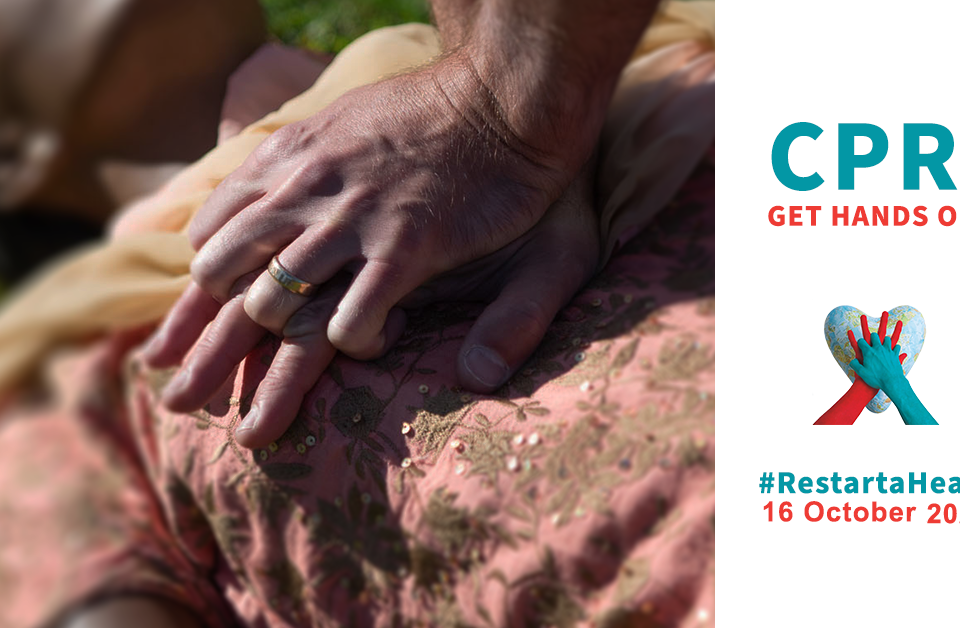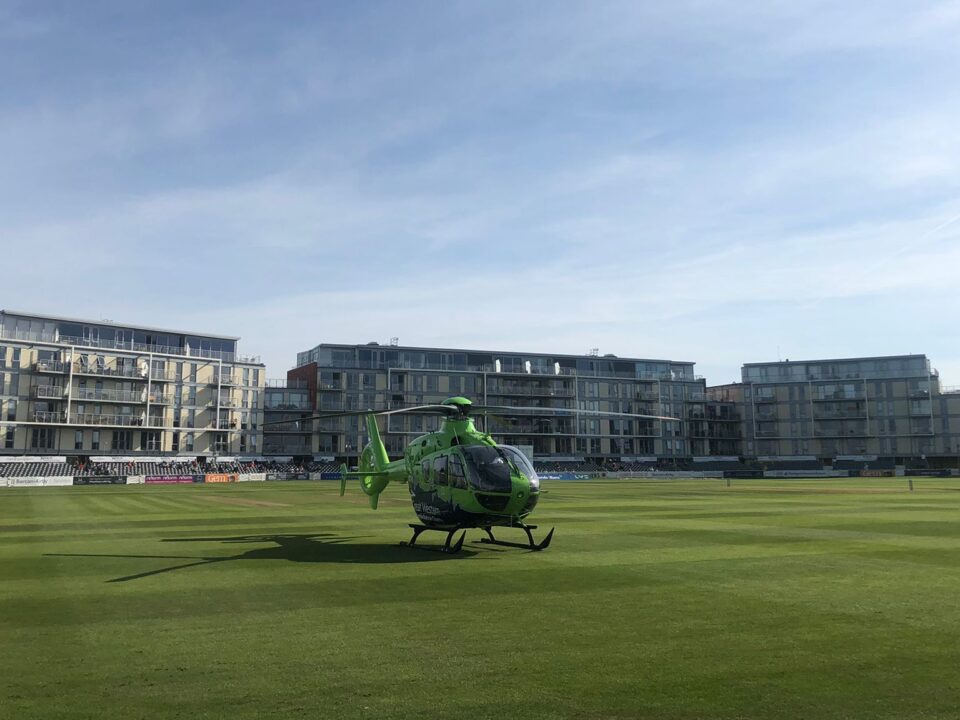October 16, 2021
Anyone can be affected by a sudden cardiac arrest at any time, and without intervention, the person will quickly die.
When someone collapses and stops breathing normally, it is important to quickly call 999, perform CPR and use a defibrillator. This gives the person their best chance of survival. If reluctant or unable to do rescue breaths, hands-only CPR will still give the person the same chance.
Be confident to intervene! Everyone, in every community, has a role to play in the chain of survival, whether it’s by calling 999, doing chest compressions, locating a defibrillator, retrieving it or by telling others what to do.
When someone collapses and stops breathing normally, it is important to quickly call 999, perform CPR and use a defibrillator. This gives the person their best chance of survival. If reluctant or unable to do rescue breaths, hands-only CPR will still give the person the same chance.
Be confident to intervene! Everyone, in every community, has a role to play in the chain of survival, whether it’s by calling 999, doing chest compressions, locating a defibrillator, retrieving it or by telling others what to do.
Survival rates from out of hospital cardiac arrest remain stubbornly low in the UK, with fewer than one in ten people surviving.1
Thousands of lives could be saved every year if CPR was taught more widely.2
There are more than 30,000 out-of-hospital cardiac arrests in the UK every year, and every minute without CPR and defibrillation reduces the chance of survival by up to 10%.
When someone has a cardiac arrest, performing immediate CPR can help double their chance of survival in some cases.3
Most episodes (around 80%) of out-of-hospital cardiac arrest occur in the home, highlighting the potential benefit of family members trained in CPR.4
The chance of surviving a cardiac arrest is tripled when an AED is available via a public-access defibrillation programme.
There are more than 30,000 out-of-hospital cardiac arrests in the UK every year, and every minute without CPR and defibrillation reduces the chance of survival by up to 10%.
When someone has a cardiac arrest, performing immediate CPR can help double their chance of survival in some cases.3
Most episodes (around 80%) of out-of-hospital cardiac arrest occur in the home, highlighting the potential benefit of family members trained in CPR.4
The chance of surviving a cardiac arrest is tripled when an AED is available via a public-access defibrillation programme.
1) BHF analysis of OHCA figures where available.
2) Nolan, J.P et al (2010): European Resuscitation Council Guidelines for Resuscitation 2010, Resuscitation 2010;81:1219-1451.
3) Resuscitation to Recovery, https://www.resus.org.uk/publications/resuscitation-to-recovery/
4) Valenzuela TD, 2. Roe DJ, 3. Nichol G, et al : Outcomes of Rapid Defibrillation by Security Officers after Cardiac Arrest in Casinos. N Engl J Med 2000;343:1206–9. doi:10.1056/NEJM200010263431701 CrossRefPubMedWeb of ScienceGoogle Scholar
2) Nolan, J.P et al (2010): European Resuscitation Council Guidelines for Resuscitation 2010, Resuscitation 2010;81:1219-1451.
3) Resuscitation to Recovery, https://www.resus.org.uk/publications/resuscitation-to-recovery/
4) Valenzuela TD, 2. Roe DJ, 3. Nichol G, et al : Outcomes of Rapid Defibrillation by Security Officers after Cardiac Arrest in Casinos. N Engl J Med 2000;343:1206–9. doi:10.1056/NEJM200010263431701 CrossRefPubMedWeb of ScienceGoogle Scholar
A cardiac arrest is when someone’s heart
suddenly stops beating, and their breathing
is abnormal or has stopped.
Without quick action, the person will die. Check for danger, then immediately follow these simple steps to give the person their best chance of survival:
1. Shout for help.
• Shake them gently.
2.Look and listen for signs of normal breathing.
• Look for the rise and fall of their chest.
3. Call 999. Put the phone on loudspeaker and tell them you are with someone who is not breathing.
4. The ambulance call handler will tell you where the nearest automated external defibrillator (AED) is. If someone is with you, ask them to fetch it and bring it back.
Do not leave the person if you are on your own.
5.Start chest compressions:
• interlock your fingers
• place your hands in the centre of the chest
• push down hard and then release twice per second, and don’t stop.
The ambulance call handler will help you.
If reluctant or unable to do rescue breaths, hands only CPR will still give the person the same chance of survival.
6. If you have a defibrillator, switch it on and follow the instructions. It will tell you exactly what to do.
7. Continue CPR until:
• the AED asks you to pause while it reanalyses and gives another shock if needed
• a paramedic arrives and tells you what to do
• the person shows signs of life.
Without quick action, the person will die. Check for danger, then immediately follow these simple steps to give the person their best chance of survival:
1. Shout for help.
• Shake them gently.
2.Look and listen for signs of normal breathing.
• Look for the rise and fall of their chest.
3. Call 999. Put the phone on loudspeaker and tell them you are with someone who is not breathing.
4. The ambulance call handler will tell you where the nearest automated external defibrillator (AED) is. If someone is with you, ask them to fetch it and bring it back.
Do not leave the person if you are on your own.
5.Start chest compressions:
• interlock your fingers
• place your hands in the centre of the chest
• push down hard and then release twice per second, and don’t stop.
The ambulance call handler will help you.
If reluctant or unable to do rescue breaths, hands only CPR will still give the person the same chance of survival.
6. If you have a defibrillator, switch it on and follow the instructions. It will tell you exactly what to do.
7. Continue CPR until:
• the AED asks you to pause while it reanalyses and gives another shock if needed
• a paramedic arrives and tells you what to do
• the person shows signs of life.
Guest post by The Resus Council UK. Resuscitation Council UK is saving lives by developing guidelines, influencing policy, delivering courses and supporting cutting-edge research. Through education, training and research, they’re working towards the day when everyone in the country has the skills they need to save a life.
- All
- Bath
- Bristol
- Cardiac
- Challenge Events
- Children
- Clinical Engagement Blog
- Clinical pathways
- Corporate
- Covid-19
- Crew
- CRM
- Events
- Field Based Volunteer Positions (South West Area)
- Fundraising
- Gloucestershire
- Legacy
- More on our kit
- News
- North Somerset
- Partner
- Patient Stories
- Research
- Retail
- South Gloucestershire
- Special Events Previous
- Sustainability
- Training
- Uncategorized
- video
- Volunteer Positions
- Volunteers
- Wiltshire
October 15, 2021
September 24, 2021
September 7, 2021
August 27, 2021
Monday 6th – Sunday 12th September – Air Ambulance Week 2021 This is the week dedicated to Air Ambulances, when all 21 Air Ambulance charities get […]
August 13, 2021
August 9, 2021
We’re excited to announce the opening of our second shop in Yate’s Shopping Centre. Our new shop was opened in a small celebration on Saturday 7 […]
July 15, 2021
2021 has been a busy year for our Critical Care Team so far, with a 30% rise in the number of call-outs in the first six […]
June 29, 2021
Each year, 30,000 people will experience a cardiac arrest outside of a hospital – in places such as their home, at work or out in public. […]








